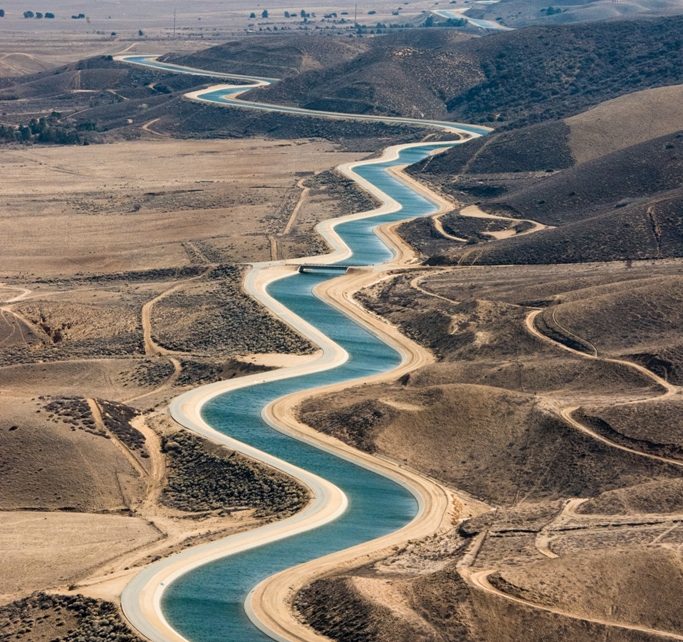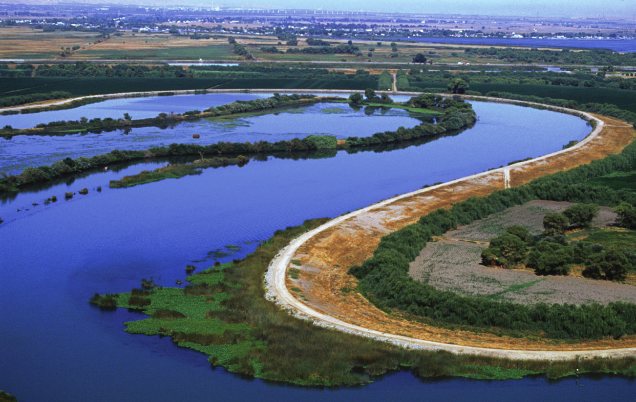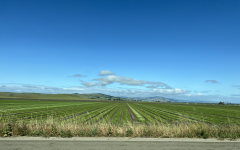
The California Aqueduct. (Photo: CA State Water Project)
Ringside: How to Achieve Water Abundance in California
Solving California’s water supply challenges is impossible without significant reform to our state’s regulatory and legal environment
By Edward Ring, August 8, 2024 7:00 am
A study released in May, The Magnitude of California’s Water Challenges, anticipated annual statewide water supply losses in the coming decades as follows: ending groundwater overdraft 2-3 million acre-feet (MAF), less from the Colorado River 0.5-0.8 MAF, climate change 1-3 MAF, and increases to required environmental flows 1-2 MAF. The total losses? 4.6 to 9 MAF per year. It’s easy enough to quibble over these estimates, but a more productive response is to propose ways we can sustainably harvest more water in California. So that’s what we have done.
Working with Steve Hilton, founder of the new organization Golden Together, we spent several months researching the issues, and last week released the result. Simply titled “Water Abundance,” the report can be accessed on Golden Together’s website and also on the California Policy Center website. In the course of preparing this document, we had the opportunity to talk with people at water agencies and trade associations, farmers, lobbyists, activists, bankers, engineers, journalists, developers, and academic experts. Many of the people we spoke with had helped write the Water Infrastructure Funding Act, a ballot initiative that, had it qualified for the November 2022 state ballot and been approved by voters, could have solved the problem of water scarcity. This report draws some of its recommendations from that initiative, but adds much more. Here are just some of its project and funding recommendations:
- Allocate two percent of the state’s General Fund to use for projects that increase California’s annual supply of water to farms and cities.
- Unlock immediate access to tens of billions to invest in water projects by permitting up to half of the two percent allocation to be used to pay principal and interest on construction bonds.
- Funds allocated based on an all-of-the-above project strategy, allowing Californians to repair and upgrade aqueducts, dams, water treatment plants, build off-stream reservoirs, expand existing reservoirs, invest in wastewater reuse and desalination plants, runoff capture, and aquifer recharge and recovery.
- The two percent of General Fund allocation does not expire until California’s total water supply capacity reaches at least 80 million acre feet per year, with a minimum of 10 MAF per year for urban use and 35 MAF per year for agricultural use, with the remaining capacity available for environmental use.
- Prioritize maintenance, repair and upgrades for projects to deliver abundant and affordable drinking water to underserved communities.
- Funds legal defense of projects approved by the California Water Commission and other water agencies against frivolous lawsuits designed to delay the completion of projects.
We estimate that a complete overhaul of California’s water infrastructure, not only including investment in water supply infrastructure, but also investment to restore and replace, for example, municipal water systems that have failed, will cost $150 billion. Two points may help put this eye-watering sum in context.
First of all, the original California Water Plan was much bigger. It had a total estimated construction cost of $11.8 billion, at a time when the state budget in 1957 was $1.9 billion. In 2024 dollars, $11.8 billion is worth $132 billion, while our final 2024-25 budget for state expenditures is $297 billion. In 1957, the state committed to water projects they estimated would cost more than six times the entire amount of that year’s state budget. What we propose, at $150 billion, is only half as much as today’s total state government spending.
Second, for this amount of money, everything gets fixed. For approximately $75 billion, we can construct new, fish friendly Delta diversion projects to move millions of acre feet of storm runoff into mostly aquifer storage, divert flooding rivers into percolation basins, build off-stream reservoirs and expand (and dredge) existing reservoirs, recycle urban wastewater, harvest urban storm runoff, and build desalination plants. Altogether these projects could deliver 10 MAF per year or more, solving California’s water scarcity challenges. But with the other $75 billion, we could fix everything that is broken, from failing municipal water systems, neglected levees, and damaged aqueducts, to funding projects that creatively merge the overlapping benefits of storm diversions, wetland and habitat restoration, flood irrigation, and aquifer recharge.
Solving California’s water supply challenges is impossible, however, without significant reform to our state’s regulatory and legal environment. Without major reforms, important projects will never get started, private investors will not participate, and projects that are approved will take decades longer than necessary and cost billions, if not tens of billions, more than they might have cost in a less punitive system. Here are just a few of the many regulatory reforms we propose:
- End the private right of action under CEQA; restrict the right to file CEQA lawsuits to District Attorneys in California’s counties and the State Attorney General.
- Repeal the “Conservation as a Way of Life” legislation which creates a disincentive for water agencies to invest in new water supply infrastructure.
- Grant the Governor and California’s Natural Resources Secretary the authority to override and approve any permit that is denied by the California Coastal Commission.
- Limit the number of hearings on a project, and require subsequent hearings to take place within 30 days of the previous hearing.
- Establish “by right” criteria for water agencies to dredge river channels and reservoir bottoms to improve throughput capacity and storage capacity.
- Streamline the permitting process to allow farmers to divert flood water onto their fields and dedicated percolation basins.
- Halt efforts to rewrite the endangered species Biological Opinions released in 2019, which restored some operational flexibility to the state and federal pumping plants that move water from the Delta into southbound aqueducts.
- Prioritize actions to mitigate other factors affecting species health and survival that do not rely on increasing unimpaired flows and controlled releases into the rivers. These include regulations and investments to reduce discharge of pollutants, restore habitat, control invasive species, and make revisions to commercial and sport fishing management policies.
- Establish criteria whereby water quality control plans that reduce pollution, restore habitat, and manage invasive species can qualify participating water agencies to withdraw greater allocations of surface water exports from the Delta.
- Remove limits on commercial and sport fishing of nonnative fish.
- Revitalize California’s commercial timber industry in order to increase the quantity and quality of runoff into our rivers.
This is not the complete list. More detail and more reform suggestions are to be found in the full document. One final thought: while researching and writing this report we encountered a surprising degree of agreement on dramatic reforms to streamline environmentalist-inspired regulations from unexpected sources, including many Democrats, many social and environmental justice advocates, and many people who are acutely concerned about climate change. There is a growing frustration with what is being increasingly recognized as environmentalist extremism.
Abundant water translates into everything good. Affordability. Resilience. Equity. Sustainability. More options for habitat restoration and maintenance. Adaptability to climate change. Conservation is not enough. If you put a fat person on a diet until they’re skinny, one minor food shortage will kill them. This is a good metaphor for what we’re doing if we go any further with conservation. Spending money – a lot of money – is not enough, either, even though it will be necessary. Restoring water security to California requires restoring a balance between environmentalist influence and the interests of everyone and everything else, including, ironically, the environment itself. Let’s get busy.
- Ringside: Green Hydrogen in California - May 15, 2025
- Ringside: Saving California’s Rural Water Users - May 8, 2025
- Ringside: How to Add 10 Million Acre Feet Per Year to California’s Water Supply - April 30, 2025








The revenue/taxes collected on the important timber harvesting would also help pay for the costs of this plan. With a proper harvesting plan, you are correct in stating that there would be more runoff coming out of the mountains. This would also have beneficial effects on the homeowner’s insurance crisis and bring the costs down which again helps the state budget. Lastly firefighting costs would also go down with a healthy managed forest the fires would be smaller and there would be fewer. Shortly after the Rough Fire in 2015 I was listening to a Ranger explain how the fire burned and how the drought had affected the trees and the bark beetle population I asked the simple question about how many trees a healthy forest should have per acre. She stuttered and stammered and quickly changed the subject. The bottom-line is that ALL of the crisis’s that California faces today are manmade. With commonsense leadership these issues can be solved which provides the opportunity for the future
Thank you for putting this out there for public discourse so that people can understand how MESSED UP California is under Democrat rule….
We can do better, and getting rid of Newsom, Bonta and 95% of all Democrat lawmakers would be a worthwhile effort…
Vote accordingly this November, and in such numbers that we break the fraudhold that the CORRUPT DEMOCRAT party has on the state…
Totally agree with you! We need to get our state back by getting rid of the Demwit majority and get some people in office who actually have run a business!
their ineptness is intentional! just another tactic to destroy Our Country as we know it! thank you for what you are doing!